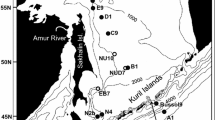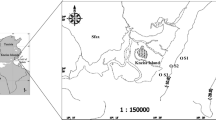Abstract
The diel vertical migration and distribution of planktonic copepods were investigated at three localities in Lake Tanganyika. During the day, the surface zone was usually totally devoid of crustacean zooplankton. Even naupliar stages of Copepoda, were often absent in the surface zone in daytime, although they were numerous at night. There were clear differences in vertical distribution between species and localities, as well as between the seasons. Cyclopoida were generally found nearer the surface, as compared to the calanoid Tropodiaptomus simplex (especially in the southern arm of the lake). The maximum abundance of Cyclopoida was found both day and night at depths between 20 and 50 m. Occasionally Cyclopoids were found below 50 m and then, only in the southern end of the lake, in the Mpulungu area. Calanoids, in comparison, utilised a broader depth range. Maximum numbers were found below 100 m, but they were also very common down to 140 m. The maximum depth of their distribution was 220 m, but only in the southern part of the lake. The lower limit of vertical distribution and migration of crustaceans was evidently related to the low oxygen concentration in deep water. Thus the seasonal differences in the vertical distribution of Copepoda seem closely to follow the general mixing patterns of epilimnion. The different mixing patterns in the northern and southern arms of Lake Tanganyika also suggest differences in the biological components of the ecosystem. The northern arm of the lake is characterized by stratification and the predominance of Cyclopoida with short-range vertical migration, while the southern end is characterized by more mixing and the predominance of Calanoida, with extended vertical migration.
Similar content being viewed by others
References
Allan, D. J., 1976. Life history patterns of zooplankton. Am. Nat. 110: 165–179.
Begg, G.W., 1976. The relationship between the diurnal movements of some of the zooplankton and the sardine Limnothrissa miodon in Lake Kariba, Rhodesia. Limnol. Oceanogr. 21: 529–539.
Chene, G., 1975. Etude des problèmes relatif aux fluctuations piscicoles du lac Tanganyika. Memoire de licence, Universite de Liege, Belgium: 1–108.
Coulter, G. W. (ed.), 1991. Lake Tanganyika and its Life. Oxford University Press, London: 354 pp.
Cushing, D. H., 1989. A difference in structure between ecosystems in strongly stratified waters and in those that are only weakly stratified. J. Plankton Res. 11: 1–3.
Elster, H. J., 1954. Ñber die Populationsdynamik von Eudiaptomus gracilis Sars und Heterocope borealis Fischer in Bodensee-Obersee. Arch. Hydrobiol. Suppl. 20: 546–614.
Edmond, J. M., R. F. Stallard, H. Craig, R. F. Weiss & G. W. Coulter, 1993. Nutrient chemistry of the water column of Lake Tanganyika. Limnol. Oceanogr. 38: 725–738.
Flinkman, J., I. Vuorinen & E. Aro, 1992. Planktivorous Baltic herring prey selectively on reproducing copepods and cladocerans. Can. J. Fish. Aquat. Sci. 49: 73–77.
Hecky, R. E., 1991. The pelagic ecosystem. In G. W. Coulter (ed.), Lake Tanganyika and its Life. Oxford University Press, London: 354 pp.
Hecky, R. E., E. J. Fee, H. J. Kling & J. W. Rudd, 1978. Studies on the planktonic ecology of Lake Tanganyika. Canadian Depart121 ment of Fish and Environment, Fisheries and Marine Service, Technical report, 816: 1–51.
Hutchinson, G. E., 1967. Treatise on Limnology, 2. Wiley & Sons, New York: 1115 pp.
Huttula, T. & V. Podsetchine, 1994. Hydrological modelling on Lake Tanganyika, FAO/FINNIDA Research for the Management of The Fisheries on Lake Tanganyika. GCP/RAF/271/FINTD/ 20 (En): 19 pp.
Huttula, T., V. Podsetchine, A. Peltonen, P. Kotilainen & H. Mölsä, 1994. Hydrology of lake Tanganyika. Nordisk Hydrologisk Program, NHP-rapport 34: 43–52.
Kiørboe, T., H. Kaas, B. Kruse, F. Mohlenberg, P. Tiselius, & G. Aertebjerg, 1990. The structure of the pelagic food web in relation to water column structure in the Skagerrak. Mar. Ecol. Prog. Ser. 55: 229–234.
Kiørboe, T., 1993. Turbulence, phytoplankton cell size and the structure of pelagic food webs. Adv. Mar. Biol. 29: 1–72.
Kurki, H., 1993. Field notes on zooplankton. FAO/FINNIDA Research for the Management of the Fisheries on Lake Tanganyika. GCP/RAF/271/FIN-FM/09 (En): 26 pp.
Kurki, H., P. Mannini, I. Vuorinen, E. Aro, O. Lindquist & H. Mölsä, 1999. Macrozooplankton communities in Lake Tanganyika indicate food chain differences between the northern part and the main basins. Hydrobiologia 407: 125–131.
Lampert, W., 1989. The adaptive significance of diel vertical migration of zooplankton. Funct. Ecol. 3: 21–27.
Mann, K. H., 1993. Physical oceanography, food chains and fish stocks: a review. ICES J. Mar. Sci. 50: 105–119.
Mann, K. H. & A. Lazier, 1991. Dynamics of marine ecosystems. Biological-physical interactions in the oceans. Blackwell Scientific Publishers.
Mannini, P., E. Aro, I. Katonda, B. Kassaka, C. Mambona, G. Milindi, P. Paffen & P. Verburg, 1996 Pelagic Fish Stocks of Lake Tanganyika: biology and exploitation. FAO/FINNIDA Research for the Management of the Fisheries on Lake Tanganyika. GCP/RAF/271/FIN-TD/53 (En): 85 pp.
Mizuno, T., 1988. Vertical distribution of plankters in northern part of Lake Tanganyika. In H. Kawanabe & M.K. Kwetuenda (eds), Ecological and Limnological Study on Lake Tanganyika and its Adjacent Regions. Department of Zoology, Kyoto University, 5: 60–61.
Mulimbwa, N. & D. Bwebwa, 1987. Seasonal changes in vertical distribution of zooplankters in Lake Tanganyika. In H. Kawanabe & M. Nagoshi, (eds), Ecological and Limnological Study on Lake Tanganyika and its Adjacent Regions. Department of Zoology, Kyoto University, 4: 119–121.
Mulimbwa, N., 1988. Seasonal changes in the abundance of zooplankters in the northwestern end on Lake Tanganyika during 1987. In H. Kawanabe & M. K. Kwetuenda (eds), Ecological and Limnological Study on Lake Tanganyika and its Adjacent Regions. Department of Zoology, Kyoto, 5: 57–59.
Mulimbwa, N., 1991. Seasonal changes in the abundance of zooplankters in the northwestern end of Lake Tanganyika. In H. Kawanabe & M. Nagoshi, (ed.), Ecological and Limnological Study on Lake Tanganyika and its Adjacent Regions. Department of Zoology, Kyoto University, 7: 96–97.
Narita, T., 1983. Species composition, vertical distribution and density of zooplankters, and some limnological features off the coast of Mahale mountains in Lake Tanganyika. In H. Kawanabe (ed.), Ecological and Limnological Study on Lake Tanganyika and its Adjacent Regions. Department of Zoology, Kyoto University, 2: 12–14.
Narita, T., N. Mulimbwa & T. Mizuno, 1986. Vertical distribution and seasonal abundance of zooplankters in Lake Tanganyika. Afr Study Monogr. 6: 1–16.
Nixon, S. W., 1988. Physical energy inputs and the comparative ecology of lake and marine ecosystems. Limnol. Oceanogr. 33: 1005–1025.
Pearre, S. J., 1979. Problems of detection and interpretation of vertical migration. J. Plankton Res. 1: 29–44.
Plisnier, P.-D., 1996 Limnological sampling during a second annual cycle (1994–1995) and some comparisons with year one on lake Tanganyika. FAO/FINNIDA Research for the Management of the Fisheries on Lake Tanganyika. GCP/RAF/271/FIN-TD/56 (En): 60 pp.
Plisnier, P.-D., V. Langenberg, L. Mwape, D. Chitamwebwa, K. Tshibangu & E. Coenen, 1996. Limnological sampling during and annual cycle at three stations on lake Tanganyika (1993– 1994). FAO/FINNIDA Research for the Management of the Fisheries on Lake Tanganyika. GCP/RAF/271/FIN-TD/46 (En): 136 pp.
Rotschild, B. J. & T. R. Osborn, 1988. Small-scale turbulence and plankton contact rates. J. Plankton Res. 10: 465–474.
Sandström, O., 1980. Selective feeding by Baltic herring. Hydrobiologia 69: 199–207.
Salonen, K. & J. Sarvala, 1994. Sources of energy for secondary production in Lake Tanganyika. Objectives, approaches and initial experiences. FAO/FINNIDA Research for the Management of the Fisheries in Lake Tanganyika. GCP/RAF/271/FIN-TD/26 (En): 30 pp.
Sarvala, J. & K. Salonen, 1995. Preliminary experiments on phytoplankton production ecology in Lake Tanganyika. FAO/FINNIDA Research for the Management of the Fisheries in Lake Tanganyika. GCP/RAF/271/FIN-TD/36 (En): 38 pp.
van Meel, L., 1954. Le phytoplancton. Résultats scientifiques de l'éxploration hydrobiologique du Lac Tanganyika (1946–1947). Institut Royal des Sciences Naturelles de Belgique, A., 5: 571–586.
Vuorinen, I., 1993. Sampling and counting zooplankton of Lake Tanganyika. FAO/FINNIDA Research for the Management of the Fisheries in Lake Tanganyika. GCP/RAF/271/FIN-FM/06 (En):19 pp.
Vuorinen, I. & H. Kurki, 1994. Preliminary results of zooplankton sampling in lake Tanganyika. FAO/FINNIDA Research for the Management of the Fisheries on lake Tanganyika. GCP/RAF/271/FIN-TD/22 (En): 37 pp.
Author information
Authors and Affiliations
Rights and permissions
About this article
Cite this article
Vuorinen, I., Kurki, H., Bosma, E. et al. Vertical distribution and migration of pelagic Copepoda in Lake Tanganyika. Hydrobiologia 407, 115–121 (1999). https://doi.org/10.1023/A:1003789415330
Issue Date:
DOI: https://doi.org/10.1023/A:1003789415330




